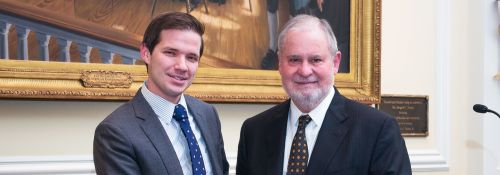
A Law Student’s Dream
Paul Ray, ’08, On The Experience Of Clerking For Supreme Court Justice Samuel Alito
Written by Sarah Chavey
In the cold winter months in Washington, D.C., Paul Ray sat next to the fireplace discussing the Constitution with three other clerks and Supreme Court Justice Samuel Alito. Maybe life gets better than this, he thought, but I’m not sure how.
For a lawyer-to-be, clerking in the office of a Supreme Court Justice is an incredible honor. Hillsdale alumnus Paul Ray, ’08, was privileged enough to spend a year clerking with Justice Alito.
“It was incredible to see how one of the greatest thinking minds of our time thinks about the law, but it was even better to see that great seriousness combined with the great kindness he displayed towards clerks,” Paul said.
An English major, Paul didn’t originally intend to become a lawyer. It was during Dr. Arnn’s Churchill class that he began to consider the possibility of a career in law.
“I realized that certain actions—such as participating in public life—can be beautiful in the same way that art can be,” Paul said. This class inspired him to continue his education at Harvard Law School. Upon graduation, he clerked in New York, practiced law for a year at Sidley Austin LLP in Washington, D.C., and then began clerking for Justice Alito.
“I thought it would be an incredible way to see the Supreme Court from the inside out, to see what it means to judge according to the Constitution, and to get to know extraordinary legal minds,” Paul said.
As a law clerk, he primarily assisted Justice Alito in three ways: participating in court proceedings, getting ready for the argument, and occasionally writing the opinion.
“I gained a deep respect for the judges because I discovered that figuring out what the statute or the Constitution means can be extremely difficult. It requires patience and humility to be receptive to what the text is telling you and refrain from imposing your own views on the law,” Paul said.
Of course, the hours were also challenging.
“It was pretty common to get to the office while it was dark and leave after it was dark,” Paul said.
When a friend wanted to catch up with Paul, he was only available to talk to the friend during his 6 a.m. commute. However, he got to go to lunch with each of the different Justices and formed lasting relationships during his one-year term.
“You’re there all the time with these people, often under stressful conditions, so you do become close,” Paul said.
Now, back at Sidley Austin LLP, he focuses on challenges to federal agency proceedings, petitioning for review of rules created by federal agencies. His time at the Supreme Court was invaluable. As he writes briefs, he thinks back to his work with Justice Alito and the techniques that were effective versus those that weren’t.
“Working at the court allowed me to see what actually persuades judges and justices,” Paul said.
Even further back, his time with the liberal arts at Hillsdale influenced his work.
“The liberal arts may not come up directly in particular cases, but they are intrinsic to the broader questions, ‘What is law?’ and, ‘What is a just political regime?’ I spent four years studying great writers and trying to write under the supervision of the faculty at Hillsdale, and that background has been a tremendous benefit.”
 Sarah Chavey is a music major from Ann Arbor, Michigan. She hopes to pursue journalism when she graduates in 2017.
Sarah Chavey is a music major from Ann Arbor, Michigan. She hopes to pursue journalism when she graduates in 2017.